Abstract
Studies were carried out to determine the effects of treatment with killed suspensions of Propionibacterium acnes (formerly designated Corynebacterium parvum) on the course of Mycobacterium leprae infection in mice. Systemic (intravenous or intraperitoneal) treatment with P. acnes failed to significantly alter the growth of M. leprae in the mouse footpad. In contrast, injections of P. acnes directly into the infected footpad markedly inhibited the growth of the leprosy bacilli regardless of whether the local treatments were administered before infection or 3 months after infection with M. leprae. The effects of local treatment with P. acnes appeared to be bactericidal and not merely bacteriostatic. Clearance of the organism from the tissues was not enhanced by P. acnes treatment.
Full text
PDF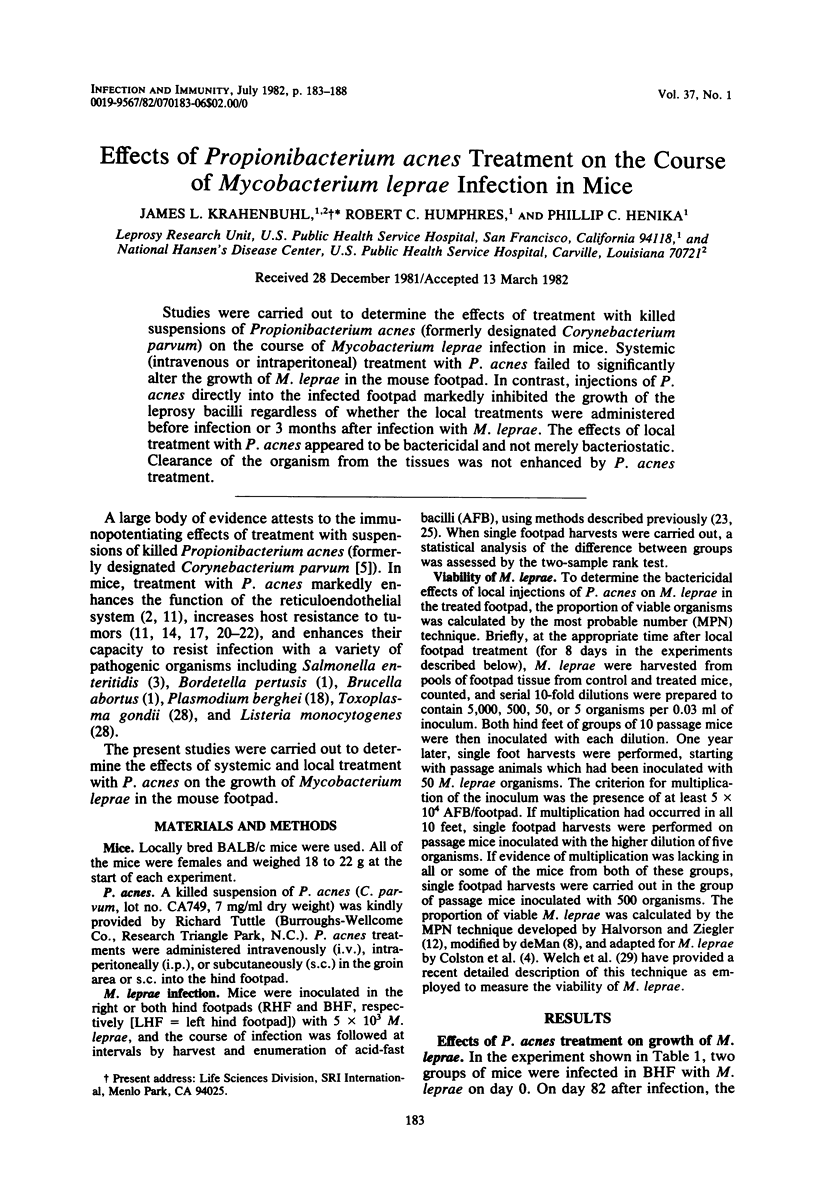
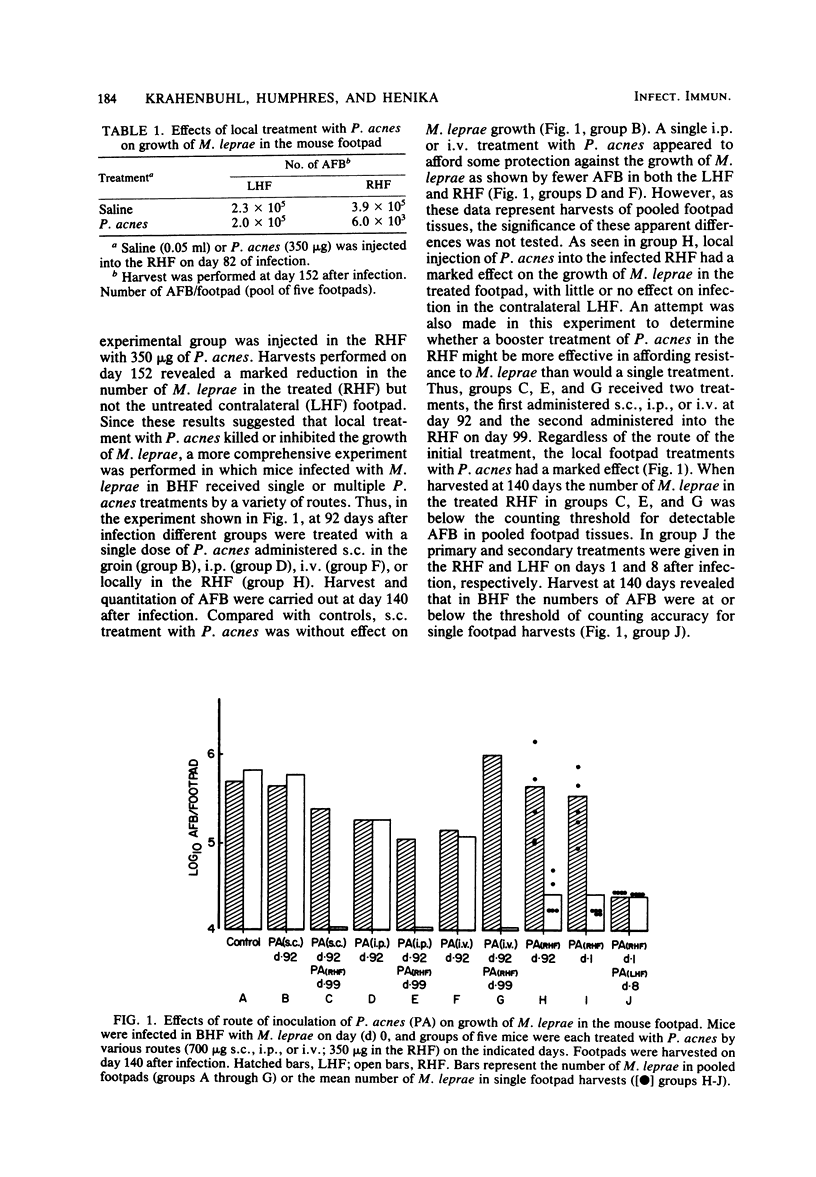
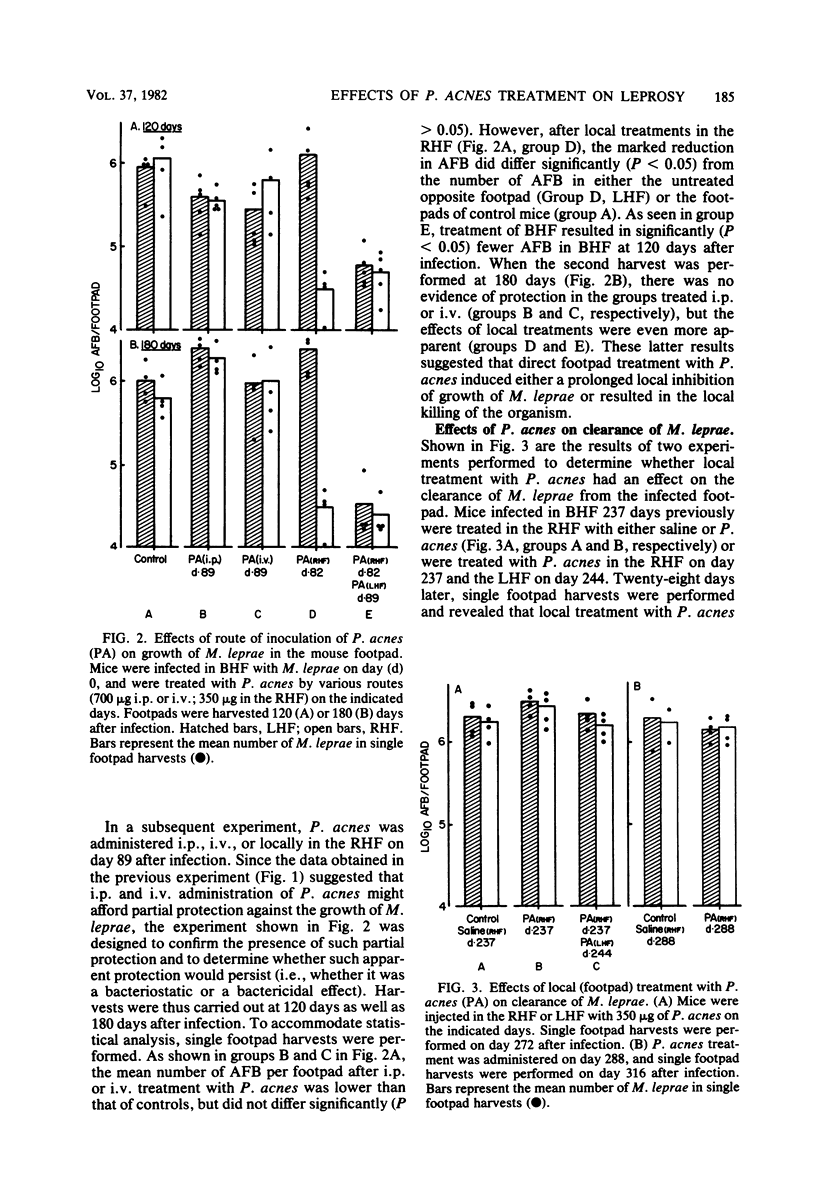
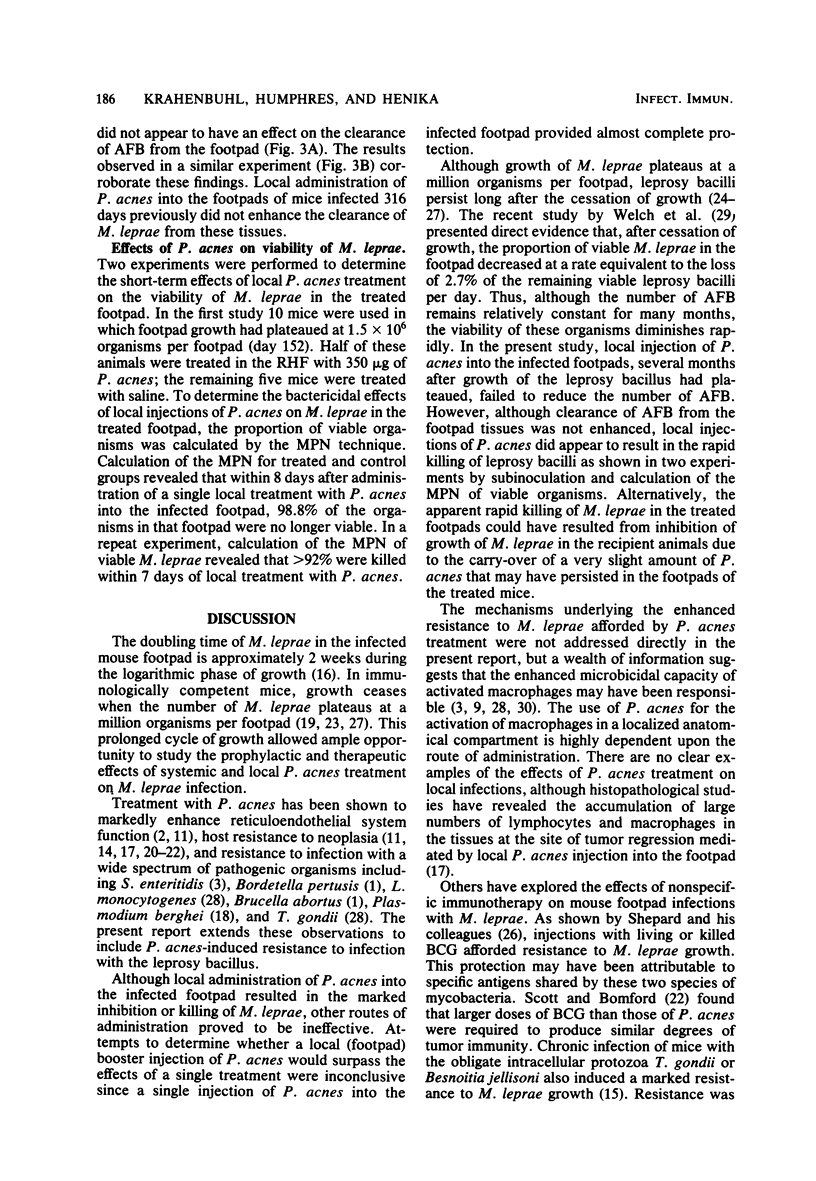
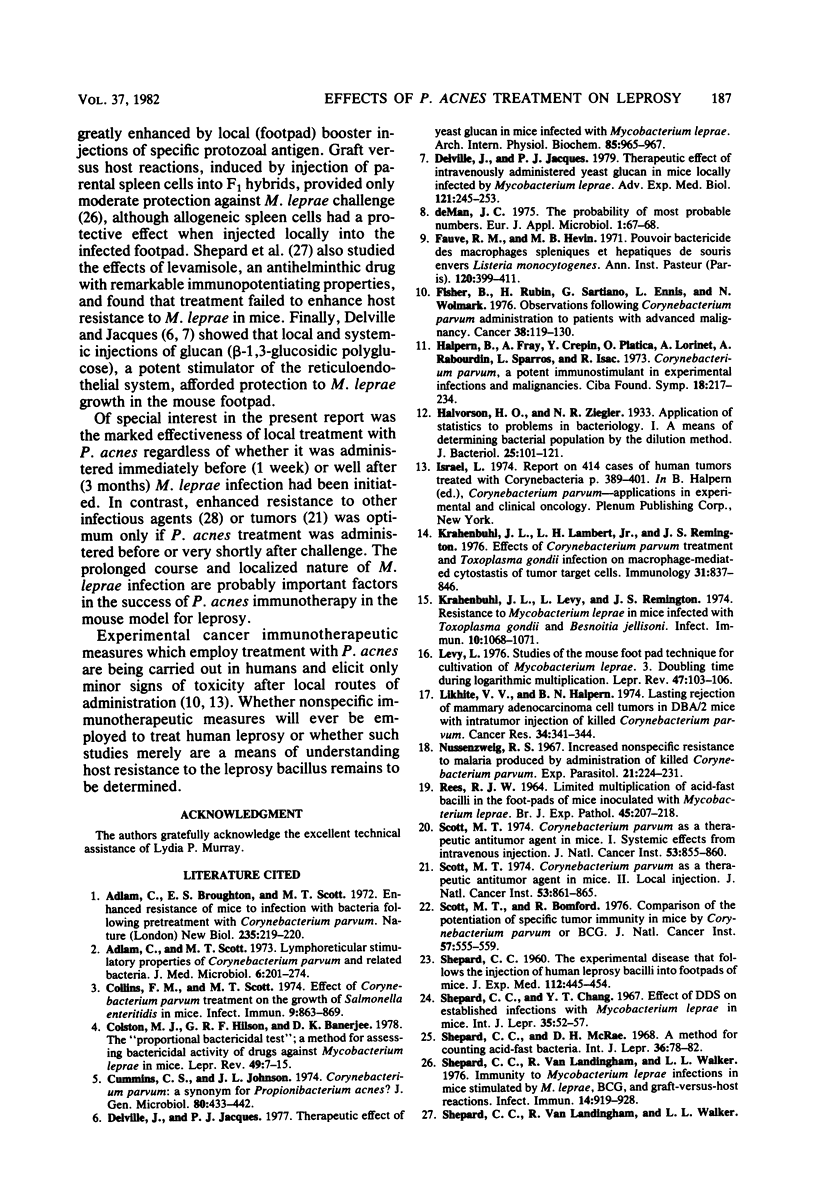
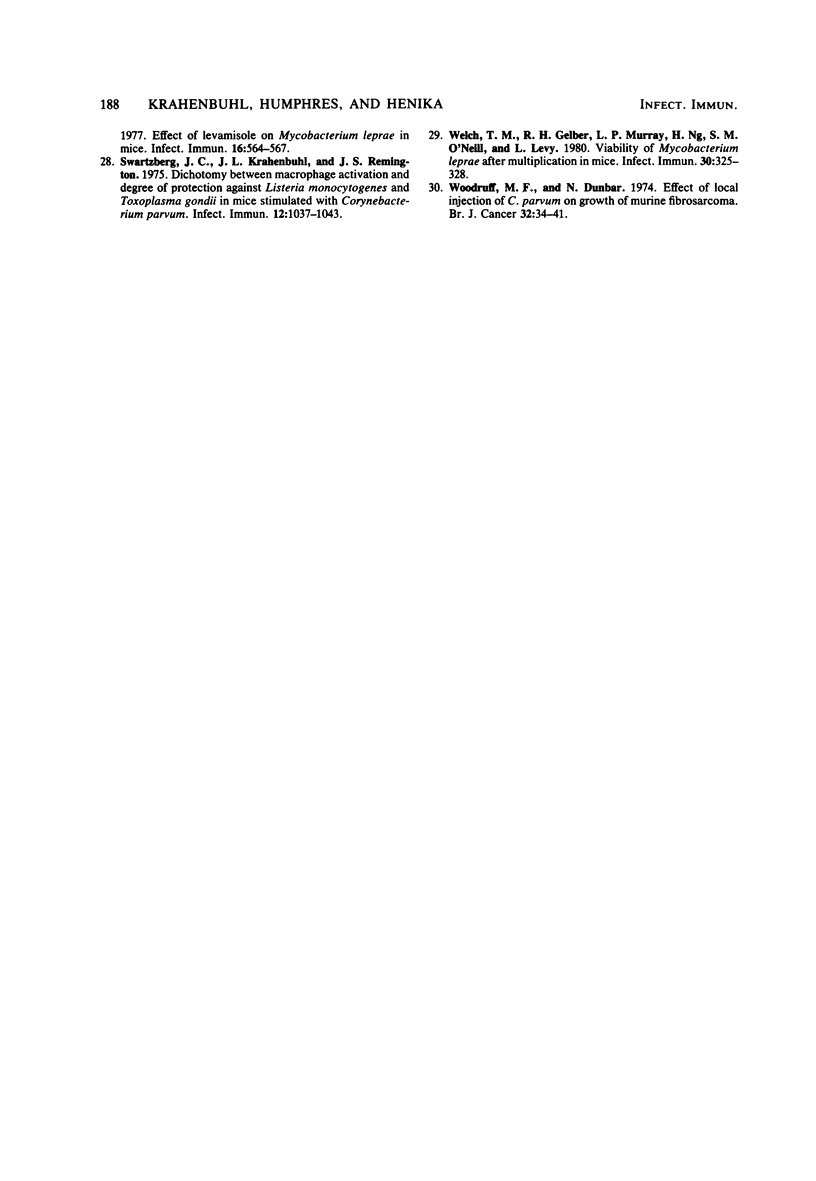
Selected References
These references are in PubMed. This may not be the complete list of references from this article.
- Adlam C., Broughton E. S., Scott M. T. Enhanced resistance of mice to infection with bacteria following pre-treatment with Corynebacterium parvum. Nat New Biol. 1972 Feb 16;235(59):219–220. doi: 10.1038/newbio235219a0. [DOI] [PubMed] [Google Scholar]
- Adlam C., Scott M. T. Lympho-reticular stimulatory properties of Corynebacterium parvum and related bacteria. J Med Microbiol. 1973 Aug;6(3):261–274. doi: 10.1099/00222615-6-3-261. [DOI] [PubMed] [Google Scholar]
- Collins F. M., Scott M. T. Effect of Corynebacterium parvum treatment on the growth of Salmonella enteritidis in mice. Infect Immun. 1974 May;9(5):863–869. doi: 10.1128/iai.9.5.863-869.1974. [DOI] [PMC free article] [PubMed] [Google Scholar]
- Colston M. J., Hilson G. R., Banerjee D. K. The "proportional bactericidal test": a method for assessing bactericidal activity in drugs against Mycobacterium leprae in mice. Lepr Rev. 1978 Mar;49(1):7–15. [PubMed] [Google Scholar]
- Cummins C. S., Johnson J. L. Corynebacterium parvum: a synonym for Propionibacterium acnes? J Gen Microbiol. 1974 Feb;80(2):433–442. doi: 10.1099/00221287-80-2-433. [DOI] [PubMed] [Google Scholar]
- Delville J., Jacques P. J. Therapeutic effect of intravenously administered yeast glucan, in mice locally infected by Mycobacterium leprae. Adv Exp Med Biol. 1979;121(A):245–253. doi: 10.1007/978-1-4684-3593-1_22. [DOI] [PubMed] [Google Scholar]
- Delville J., Jacques P. J. Therapeutic effect of yeast glucan in mice infected with Mycobacterium leprae [proceedings]. Arch Int Physiol Biochim. 1977 Dec;85(5):965–966. doi: 10.3109/13813457709053306. [DOI] [PubMed] [Google Scholar]
- Fauve R. M., Hevin M. B. Pouvoir bactéricide des macrophages spléniques et hépatiques de souris envers Listeria monocytogenes. Influence du traitement préalable des animaux par des glucocorticoides, une endotoxine, Corynebacterium parvum et l'acide polyinosinique, polycytidylique (Poly: I.C.) Ann Inst Pasteur (Paris) 1971 Mar;120(3):399–411. [PubMed] [Google Scholar]
- Fisher B., Rubin H., Sartiano G., Ennis L., Wolmark N. Observations following Corynebacterium parvum administration to patients with advanced malignancy. a phase I study. Cancer. 1976 Jul;38(1):119–130. doi: 10.1002/1097-0142(197607)38:1<119::aid-cncr2820380121>3.0.co;2-1. [DOI] [PubMed] [Google Scholar]
- Halvorson H. O., Ziegler N. R. Application of Statistics to Problems in Bacteriology: I. A Means of Determining Bacterial Population by the Dilution Method. J Bacteriol. 1933 Feb;25(2):101–121. doi: 10.1128/jb.25.2.101-121.1933. [DOI] [PMC free article] [PubMed] [Google Scholar]
- Krahenbuhl J. L., Lambert L. H., Jr, Remington J. S. Effects of Corynebacterium parvum treatment and Toxoplasma gondii infection on macrophage-mediated cytostasis of tumour target cells. Immunology. 1976 Dec;31(6):837–846. [PMC free article] [PubMed] [Google Scholar]
- Krahenbuhl J. L., Levy L., Remington J. S. Resistance to Mycobacterium leprae in Mice Infected with Toxoplasma gondii and Besnoitia jellisoni. Infect Immun. 1974 Nov;10(5):1068–1071. doi: 10.1128/iai.10.5.1068-1071.1974. [DOI] [PMC free article] [PubMed] [Google Scholar]
- Levy L. Studies of the mouse foot pad technique for cultivation of Mycobacterium leprae. 3. Doubling time during logarithmic multiplication. Lepr Rev. 1976 Jun;47(2):103–106. doi: 10.5935/0305-7518.19760019. [DOI] [PubMed] [Google Scholar]
- Likhite V. V., Halpern B. N. Lasting rejection of mammary adenocarcinoma cell tumors in DBA-2 mice with intratumor injection of killed Corynebacterium parvum. Cancer Res. 1974 Feb;34(2):341–344. [PubMed] [Google Scholar]
- Nussenzweig R. S. Increased nonspecific resstance to malaria produced by administration of killed Corynebacterium parvum. Exp Parasitol. 1967 Oct;21(2):224–231. doi: 10.1016/0014-4894(67)90084-7. [DOI] [PubMed] [Google Scholar]
- REES R. J. LIMITED MULTIPLICATION OF ACID-FAST BACILLI IN THE FOOT-PADS OF MICE INOCULATED WITH MYCOBACTERIUM LEPRAE. Br J Exp Pathol. 1964 Apr;45:207–218. [PMC free article] [PubMed] [Google Scholar]
- Scott M. T., Bomford R. Comparison of the potentiation of specific tumor immunity in mice by Corynebacterium parvum or BCG. J Natl Cancer Inst. 1976 Sep;57(3):555–559. doi: 10.1093/jnci/57.3.555. [DOI] [PubMed] [Google Scholar]
- Scott M. T. Corynebacterium parvum as a therapeutic antitumor agent in mice. I. Systemic effects from intravenous injection. J Natl Cancer Inst. 1974 Sep;53(3):855–860. doi: 10.1093/jnci/53.3.855. [DOI] [PubMed] [Google Scholar]
- Scott M. T. Corynebacterium parvum as a therapeutic antitumor agent in mice. II. Local injection. J Natl Cancer Inst. 1974 Sep;53(3):861–865. doi: 10.1093/jnci/53.3.861. [DOI] [PubMed] [Google Scholar]
- Shepard C. C., Chang Y. T. Effect of DDS on established infections with Mycobacterium leprae in mice. Int J Lepr Other Mycobact Dis. 1967 Jan-Mar;35(1):52–57. [PubMed] [Google Scholar]
- Shepard C. C., McRae D. H. A method for counting acid-fast bacteria. Int J Lepr Other Mycobact Dis. 1968 Jan-Mar;36(1):78–82. [PubMed] [Google Scholar]
- Shepard C. C., Van Landingham R., Walker L. L. Immunity to Mycobacterium leprae infections in mice stimulated by M. leprae, BCG, and graft-versus-host reactions. Infect Immun. 1976 Oct;14(4):919–928. doi: 10.1128/iai.14.4.919-928.1976. [DOI] [PMC free article] [PubMed] [Google Scholar]
- Swartzberg J. E., Krahenbuhl J. L., Remington J. S. Dichotomy between macrophage activation and degree of protection against Listeria monocytogenes and Toxoplasma gondii in mice stimulated with Corynebacterium parvum. Infect Immun. 1975 Nov;12(5):1037–1043. doi: 10.1128/iai.12.5.1037-1043.1975. [DOI] [PMC free article] [PubMed] [Google Scholar]
- Welch T. M., Gelber R. H., Murray L. P., Ng H., O'Neill S. M., Levy L. Viability of Mycobacterium leprae after multiplication in mice. Infect Immun. 1980 Nov;30(2):325–328. doi: 10.1128/iai.30.2.325-328.1980. [DOI] [PMC free article] [PubMed] [Google Scholar]
- Woodruff M. F., Dunbar N. Effect of local injection of Corynebacterium parvum on the growth of a murine fibrosarcoma. Br J Cancer. 1975 Jul;32(1):34–41. doi: 10.1038/bjc.1975.131. [DOI] [PMC free article] [PubMed] [Google Scholar]


